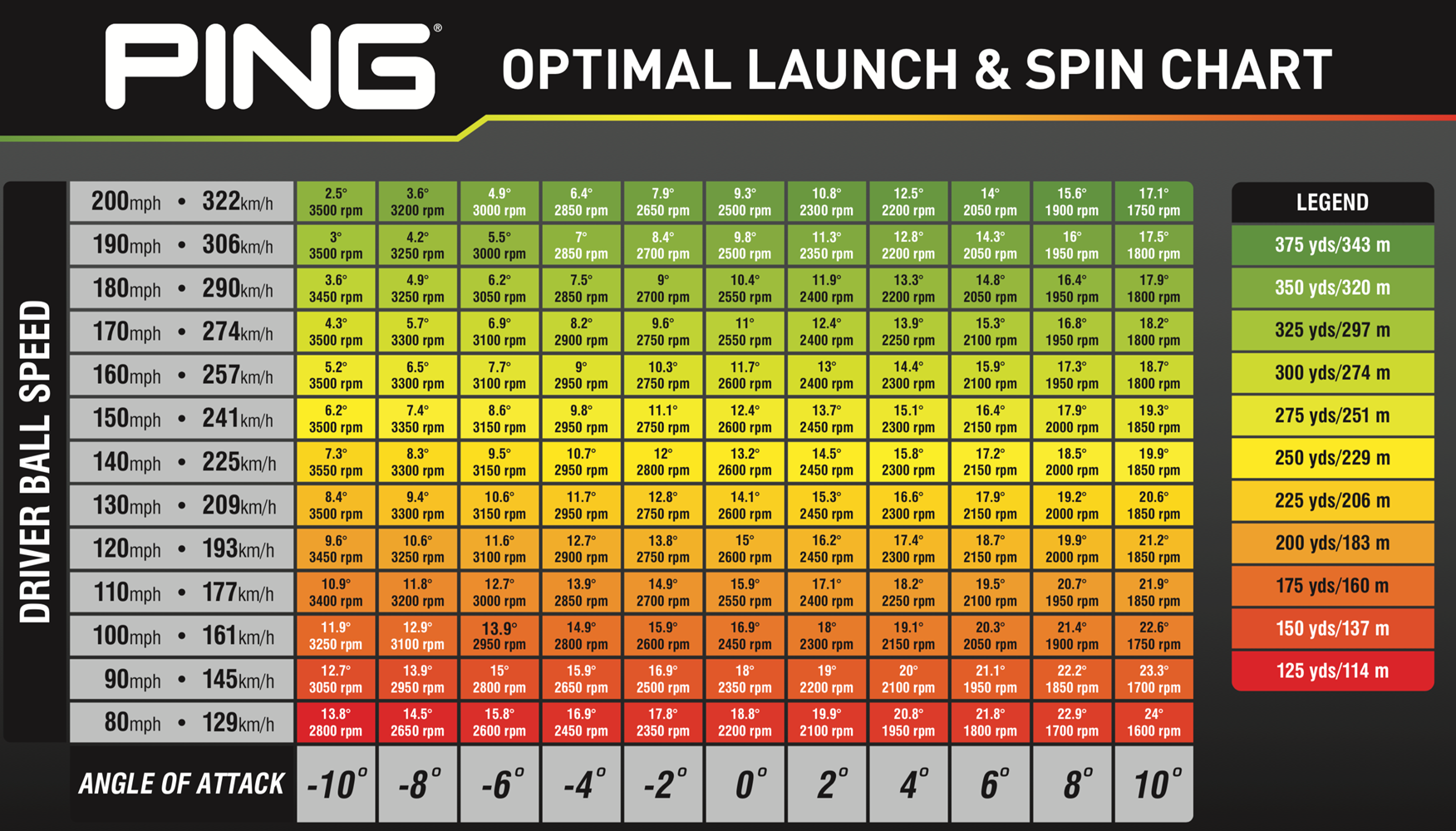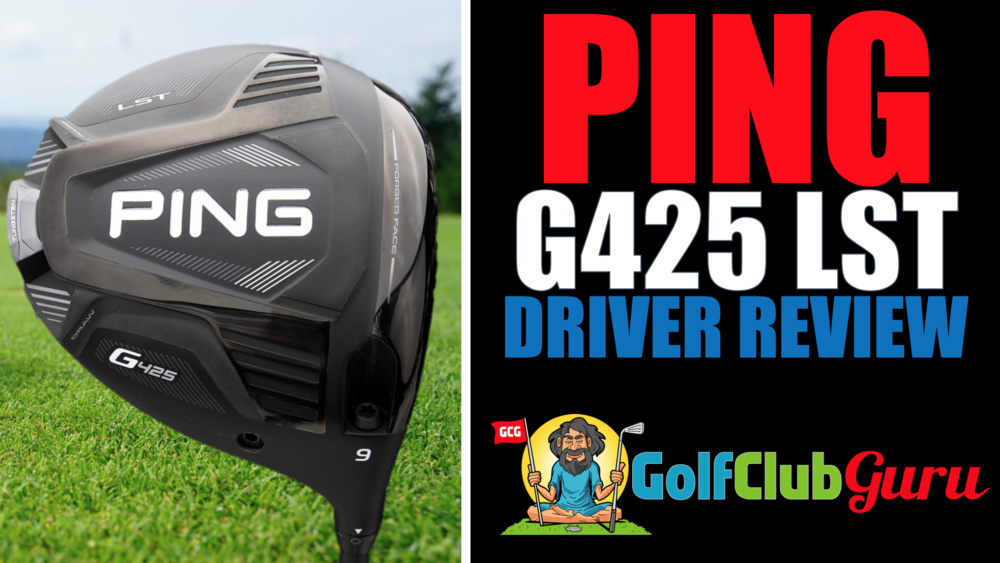First, Let’s Talk About Low Spin Drivers
You might have heard that the holy grail of driving is high launch, low spin. However, that’s not always the case. Low spin is not for everyone.
The “high launch, low spin” doesn’t take into account two very important factors: swing speed (or ball speed) and angle of attack. Ping’s experts, after hundreds of hours or research and testing, have released an incredibly valuable chart to help you determine if a low spin driver is optimal for you. Here’s that chart:


To make this chart as simple to understand as possible, here are the major points that you need to be aware of.
- Main point: fast ball speeds (150 mph) and positive angle of attack swings (those that hit up on the ball more) will hit longer, straighter drives with a low spin head.
- A swing with a negative angle of attack (hitting down on the ball; left side of the chart) will perform better with a higher spin driver head. A swing with a positive angle of attach (hitting up on the ball; right side of the chart) will perform better with a lower spin driver head.
- In general, those with faster club head speeds will perform better with lower spin rates. If you compare optimal spin rates between average swing speeds and slow swing speeds, the chart may make you think that super slow swings will work better with a low spin head as well. However, that’s not the case. The slower swingers are simply not generating enough power to create higher spin rates. A little confusing, I know.
IMPORTANT DISCLAIMER – PLEASE READ
So far, we’ve determined that the general rule is that fast swingers who hit up on the ball will perform the best with low spin drivers.
However, it’s important to keep in mind that golfers with positive angle of attacks also NATURALLY have lower spin rates. So, to truly know whether you need a low spin head, you’ll need to get professionally fitted by a club fitter. You’ll need to find out your current launch angles and spin rates to be able to make an educated decision about whether the Ping G425 LST driver will be beneficial for you.
Did that make sense? I’m going to say it again.
You won’t know whether you need a low spin driver like the Ping G425 LST unless you are sure that you are currently hitting drives with too much spin. To do that, I recommend you find a local club fitter that has great reviews among golfers in your area.
Ok, now we are ready for the Ping G425 LST Driver review.
Overall Performance & Appearance
Ping’s drivers are top notch. The G400 and G410 series have been absolutely stunning all around drivers, and the G425 series is no different. Truthfully, I think they are all practically the same though, so you can easily save money by going with the older model.
The look of the Ping G425 LST driver, at address, is just like the other models, but a tad bit more compact. The LST has a 445cc head, while the SFT and MAX heads have a 460cc. It’s common for low-spin driver heads to be a tad more compact that others.
However, it still has their popular dragon-fly design on the all-black crown, which makes the club head look bigger in my opinion. That’s great for an extra feeling of forgiveness when you are standing over the golf ball on the tee box.
On the sole of the club, you can see the tungsten weighting. This weight can be moved to the heel of the club (for a draw bias) or to the toe of the club (for a fade bias). The weight can’t be moved very far, though, so the bias won’t be massive on either side. If you want to make the bias even stronger in one direction, you can pair the weight placement with an adjustment of the hosel.
Compared to MAX and SFT
Compared to the other models in the G425 driver series, the Ping G425 LST is:
- longer and straighter for fast swing speeds (100+ mph)
- better for those that hit up on the ball more (positive angle of attack)
- a little more compact and less forgiving then the MAX and SFT on average
- more penetrating than the MAX and SFT
- less draw bias potential than the SFT
Pros & Cons
Every driver has pros & cons about it. While the manufacturers don’t want to tell you about the cons, I’ll be happy to.
Pros:
- low spin head is great for those with fast swings that hit high, spinny drives which don’t travel as far as they should
- besides the low spin aspect, simply a great drive all around. Very forgiving and great feel/sound at impact
- adjustable weight on the sole and adjustable hosel to add draw bias or fade bias and to add/subtract 1.5 degrees of loft
- comes with an Arccos smart grip, which will record/analyze shots if you’d like to utilize the smartphone app
- lower profile club head (445cc vs 460cc), which many better golfers prefer
- great for more penetrating drives, which is far better in windy conditions
Cons:
- not for everyone, even though most golfers want to believe they’d hit better with a low spin head
- less forgiving than the SFT and MAX. Truthfully, I think 95% of golfers will hit better drives with the SFT or MAX instead of the low spin LST.
- At $530, it’s super expensive for a single club. What, are you going to spend like $2,000 on your entire set of clubs? Not me. There are far better value options on the market for a low spin head, like the G400 LST or TaylorMade SLDR.
Who the Ping G425 LST Driver is Best For
Is this the driver for you? Well, it depends.
In my opinion, the Ping G425 LST driver is best for those with 1) fast swing speeds that currently have 2) too high of spin rates.
It’s hard to define “fast swing speeds”. Generally, if you are hitting the golf ball 280+ yards, you are probably going to perform better with a lower spin driver. However, this doesn’t take into account elevation, angle of attack, golf ball choice, shaft selection, etc. So use sparingly.
It’s also hard to define “too high” spin rates. But you can easily use the chart provided above to find your optimal spin rate. If you can’t (or don’t want to) be tested on a launch monitor, you can simply use your personal experience. If your drives seem to fly too high and don’t roll very much on the ground, then you probably are hitting with too much backspin. If you are terrified of hitting a drive directly into the wind because your ball drops from the sky directly downward, then you probably are hitting with too much backspin.
If you are hitting the ball with too much backspin, then you will definitely benefit from a lower spin driver. So if you fit the mold AND have lots of money to spend, then the Ping G425 LST is the driver for you.
If you fit the mold but DON’T want to shell out $500+, then continue to the next section.
Better Value Alternative: Ping G400 LST or TaylorMade SLDR
It’s not that hard to understand that a brand new release like the Ping G425 LST is at the top of the market when it comes to price. So if you are looking to get the best value, this isn’t the club for you. If you want the best value, you need to look at an older model with similar features as the Ping G425 LST driver.
Look no further than the 4 year old model: the Ping G400 LST. It doesn’t have the movable weight on the sole of the club. But other than that, they are practically the same exact driver but with a different color scheme and price tag. You can currently grab the Ping G400 LST in great condition for around $200.
If you want to save even more money, then check out the TaylorMade SLDR. Even since it’s inception, it’s been one of the most popular, lowest spin driver head on the market. And man it’s pretty old now – 6 or 7 years old at this point. But you can pick one up for lie $100-$120 in excellent condition. So, do you want to spend $120 or $530 for a driver that will work pretty similarly?







I want to thank you so much for sharing this article. I am a 57 year old lady golfer with a slower swing speed. I really need to workout more to improve my strength and flexibility. But until I actually get in better shape, I have to contend with my slower swing speed. I have had a love hate relationship with my driver for years. There have been months that the driver has not even made it into the bag.
Finally, I have useful information that will most probably help me. I live in a very small community in Southwestern VA so will probably have to travel to a bigger city to have a driver actually fitted for me. Is going to a club fitter going to break the bank?
The chart probably refers to men. But I think that you helped me a lot. I just don’t want to struggle with my driver anymore.
Thank you again from this older average lady golfer